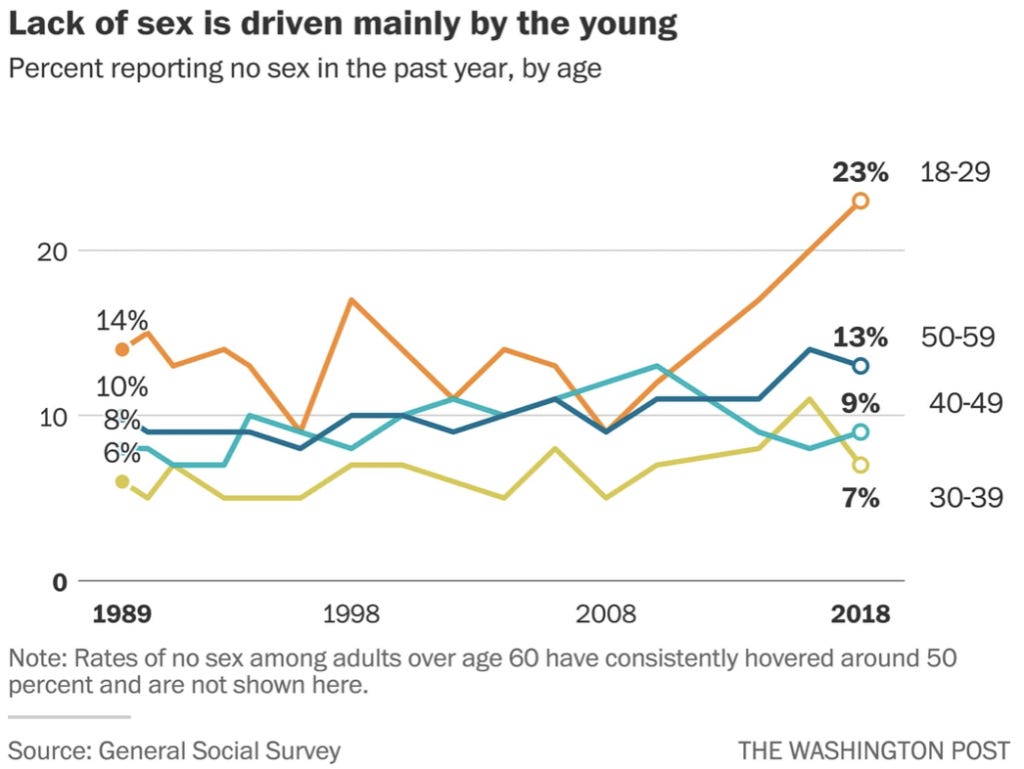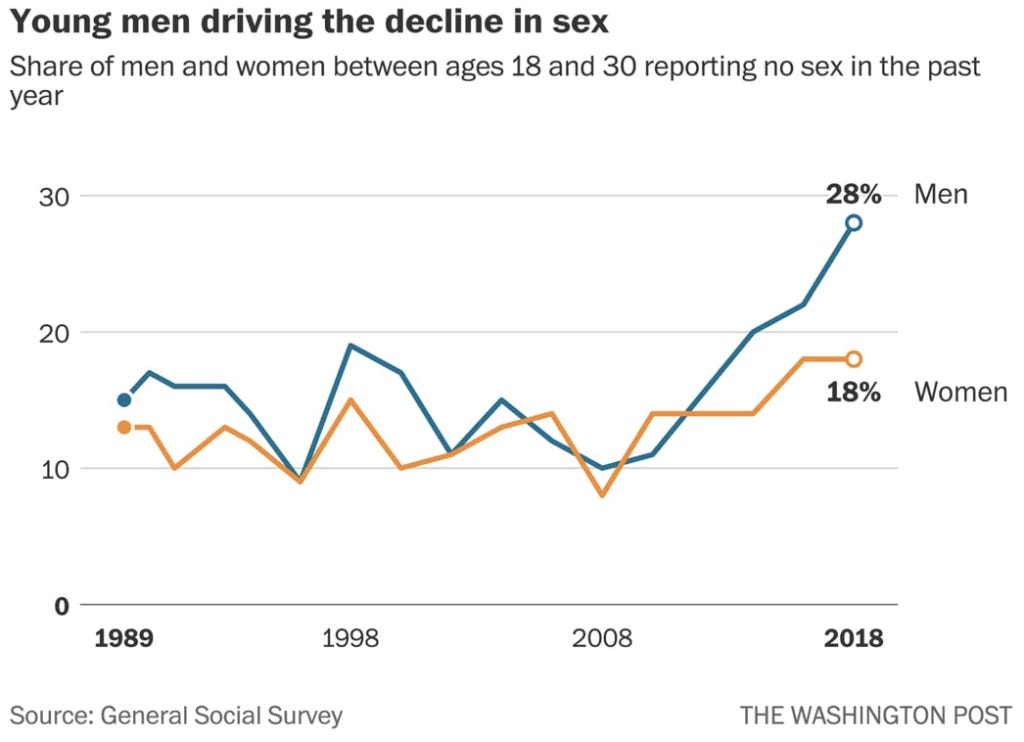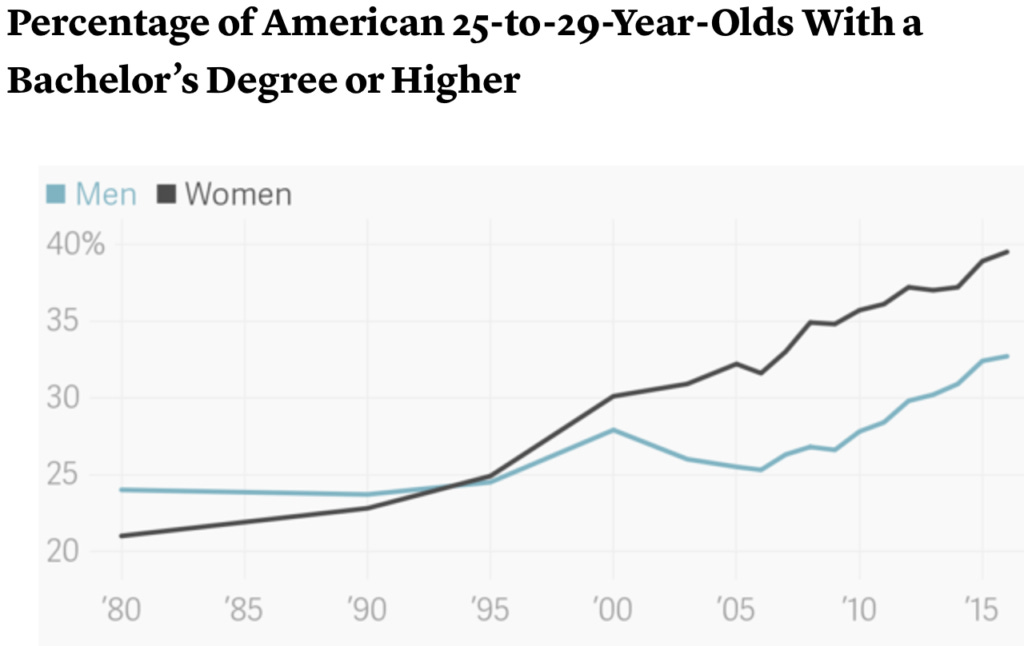According to the Post, polls say 28% of US men age 18-30 report not having sex in the last year, almost 3 times as many as a decade ago. Women that age show a much smaller increase, and other ages don’t show noticeable changes:


Even if much of this change is due to random polling error, I’d bet there is still a real effect here to explain. I asked via a Twitter poll if the young women switched to sex with older men, or with more desirable younger men, and by 3-2 (out of 11,456!), they favored the latter theory. Yes, in principle women could be switching to sex with other women, but I’d bet that’s not the biggest effect here.
So there’s probably a real effect here to explain: regarding heterosexual sex, over the last decade many more young men are having no sex, compared to other ages and genders, and with their potential partners switching to more desirable young men and older men. That’s a pattern we might want to explain.
If we think of sex as a mating market, using simple supply and demand concepts, then the (quality weighted) quantity of sex that each person gets should depend on 1) how much they value sex, 2) how much they have to offer potential partners, and 3) how much those partners value them. In addition, 4) search and other deal frictions can make it harder to find and sustain pairings.
So the young men who have less to offer, relative to average young men, might get even less sex over time because they become even less desirable in the eyes of women, because those women now find other options more attractive, because these young men are less eager for sex, or because of increased costs to find and proposition well-matched women.
These are categories of proximate causes, and are consistently with many distal causes. For example, longer lifespans could cause changes in youthful desire, or changes in outside options. Yes, each of these categories can be broken down further. For example, young men might be less eager for sex either because young women have changed and become less desirable to them, or because those men now find other activities more enjoyable.
In one of my most popular Twitter polls to date (with 4940 responses), I asked people to pick from three cause categories:
% of young men w/ no sex in year has doubled in 10 years to 28% in 2018. Which factor contributes most: they want sex less, they are objectively less desirable, or potential partners have raised their standards?
— Robin Hanson (@robinhanson) March 30, 2019
While there is no strong consensus, respondents did favor pickier young women by almost 2-1 over each of the other two options (less male desire and less desirable men). The stories of pickier women and less desirable men will in practice be pretty hard to distinguish, especially as there can be feedback loops, such as where men who succeed less get discouraged and try less hard. So let us just bundle these stories together into: PW+LDM. In my poll, that bundle is favored 3-1 over the men want sex less story.
While my poll induced many commenters to offer theories, most did not think very carefully about how to explain social changes. So let me elaborate here on that. If real, this particular pattern is regarding one particular subset of people, less-desirable young men (LDYM), who are losing out over a particular decade to another particular subset, young more-desirable men, for a particular thing, sex. So any explanation of this pattern needs to be specific to these two groups, this outcome (sex), and this time period.
Thus it won’t at all do to point to effects that are constant in time, such as people not always telling the truth in polls, or men having lower standards for sex partners. It also won’t do to point to changes over this time period that effected all ages and genders similarly, such as obesity, porn, video games, social media, dating apps, and wariness re harassment claims. They might be part of an answer, but can’t explain all by themselves. To explain an unusual burst over the last decade, it is also problematic to point to factors (e.g., computing power) that changed over the last decade, but changed just as much over prior decades.
A good theory instead needs to identify why its favored effect was much stronger in this past decade, especially for the package of LDYM. Consider the explanations mentioned by the Post:
There are several potential explanations … Labor force participation among young men has fallen, particularly in the aftermath of the last recession. … 54% of unemployed Americans didn’t have a steady romantic partner, compared with 32% among the employed. … Young men also are more likely to be living with their parents than young women: In 2014, for instance, 35% of men age 18 to 34 were living in their parents’ home, compared with 29% of women in that age group. …
One final factor that may be affecting Americans’ sexual habits at all ages is technology. “There are a lot more things to do at 10 o’clock at night now than there were 20 years ago,… Streaming video, social media, console games, everything else.” (more)
But streaming video and social media effect all ages, genders, and desirability levels, not just LDYM. The other two effects are at least specific to LDYM, but there’s no mention of just how much living at home has changed among young men, and the drop in labor force participation (e.g., 79.6-73.0% for men age 20-24 from ’06-’16) seems much less than increase in the sexless.
A related effect the Post didn’t mention is women going further in school than men now, and women being reluctant to date men with less school. There’s been a big change in that over the last 15 years:

Note that these 3 possible causes, schooling differences, labor force participation declines, and living at home, all more plausibly act through the PW+LDM channel, relative to less male desire or higher deal frictions channels.
In December, the Atlantic outlined a great many possible theories:
Fisher, like many other experts, attributes the sex decline to a decline in couplehood among young people. For a quarter century, fewer people have been marrying, and those who do have been marrying later. … But this doesn’t explain why young people are partnering up less to begin with. …
It might be a consequence of the hookup culture, of crushing economic pressures, of surging anxiety rates, of psychological frailty, of widespread antidepressant use, of streaming television, of environmental estrogens leaked by plastics, of dropping testosterone levels, of digital porn, of the vibrator’s golden age, of dating apps, of option paralysis, of helicopter parents, of careerism, of smartphones, of the news cycle, of information overload generally, of sleep deprivation, of obesity. Name a modern blight, and someone, somewhere, is ready to blame it for messing with the modern libido. …
Rates of childhood sexual abuse have decreased in recent decades, and abuse can lead to both precocious and promiscuous sexual behavior. And some people today may feel less pressured into sex they don’t want to have, thanks to changing gender mores and growing awareness of diverse sexual orientations, including asexuality. Maybe more people are prioritizing school or work over love and sex, at least for a time. …
In more recent decades, by contrast, teen romantic relationships appear to have grown less common. … Unless you are exceptionally good-looking, the thing online dating may be best at is sucking up large amounts of time. … Tinder … logs 1.6 billion swipes a day, and just 26 million matches. … overwhelming majority of matches don’t lead to so much as a two-way text exchange, much less a date, much less sex. … #MeToo movement … less healthy reactions, like avoiding romantic overtures for fear that they might be unwelcome. In my own conversations, men and women alike spoke of a new tentativeness and hesitancy. … Online daters, he argued, might be tempted to keep going back for experiences with new people; commitment and marriage might suffer. … porn may be contributing to some particularly unpleasant early sexual experiences. … Learning sex in the context of one-off hookups isn’t helping. …
Millennials don’t like to get naked—if you go to the gym now, everyone under 30 will put their underwear on under the towel, which is a massive cultural shift … Designs for master-bedroom suites were evolving for much the same reason: “They want their own changing rooms and bathrooms, even in a couple.” … May also be newly worried about what they look like naked. … Social-media use is correlated with body dissatisfaction. … a lot of men who would like to perform oral sex but are rebuffed by their partner. … Women will say … ‘It’s the ugliest part of my body.’ “ …
There may be such a thing as waiting too long. Among people who are sexually inexperienced at age 18, about 80% will become sexually active by the time they are 25. But those who haven’t gained sexual experience by their mid-20s are much less likely to ever do so. (more)
Note that many of these channels result in women being less interested in or open to male sex proposals, and are thus within the PW+LDM channel. These include less child sex abuse, feeling less pressured, prioritizing careers, women feeling more anxious about their bodies, and more #MeToo disapproval of sex proposals. (Though that last one can also be seen as higher deal frictions.) Overall, both my polls and MSM stories seem to agree that PW+LDM is the most likely channel of change here.
Note also that the “waiting too long” problem can contribute to cohort specific sex cultures. That is, age cohorts often generate distinct tastes in music, food, and hobbies, tastes which can last a lifetime. Similarly, age cohorts can generate distinct lasting sex cultures, cultures that are especially sensitive to the conditions around when that cohort first started to have sex. In general, age cohorts seem eager to change from the fashions of prior cohorts, to define themselves via distinct music, etc. And in addition, dramatic events like 9-11, the great recession, and #MeToo could help push a new age cohort to switch to a new cultural equilibrium, which might then stick around for a while, at least until the next such disruption.
It seems that, whether due to recent cultural events or random cultural drift, the latest age cohort has switched to a new sex culture wherein the less desirable half of young men are now seen as even less desirable by young women than previous cohorts would have seen them. And within this culture it is seen as more acceptable for young women to share the more desirable half of young men, relative to the higher (but never maximal) priority previous cohorts put on more monogamous ties.
Random future cultural changes could of course move back the other way. But my increasing-wealth-induces-farmer-to-forager story about the direction of modern cultural changes predicts otherwise for the long run. Via marriage, foragers were more promiscuous and less monogamous than farmers, and this recent age cohort sex culture change continues this predicted farmer-to-forager movement.
Added 10p: Some evidence against the porn story.
Added 10Apr: TGGP reviews data & concludes:
Between the two explanations, I would thus conclude that a shift toward older men relative to the 18-29 group fits better than an increase in variance within 18-29.




From what I've read, traditionalism is a big predictor of marriage & children. Attractiveness less so. For example, it has been noted that college educated urbanites tend to be relatively attractive, while less educated folks in the provinces are less so, but it is the latter who are having more children. Population geneticists looking at current fertility patterns say that the trend is toward less height and more weight, which is not typically considered an attractive combo. However, my recollection was that statistic applied particularly for women (for whom education has a particularly significant negative correlation).
The question that comes to me is whether the delay in marriage age, the lower number of marriages and the increase in number of divorces have reduced the access of men to sex. The exchange of providing for sex between men and women is quite old.It could be simply that unmarried men, unless they are very attractive, aren't getting any, and that women no longer need/want to marry unattractive men because they no longer need/want a provider, and thus can simply play the field in order to have sex and sons from the most attractive men only.
If this is the case there will be a big change in a few generations (sexual selection is quite fast): unattractive men will be expunged from the gene pool, and the percentage of very attractive men will increase a lot.
PS The above presupposes that most women are attracted to the same general type of man, and that's most likely the case.